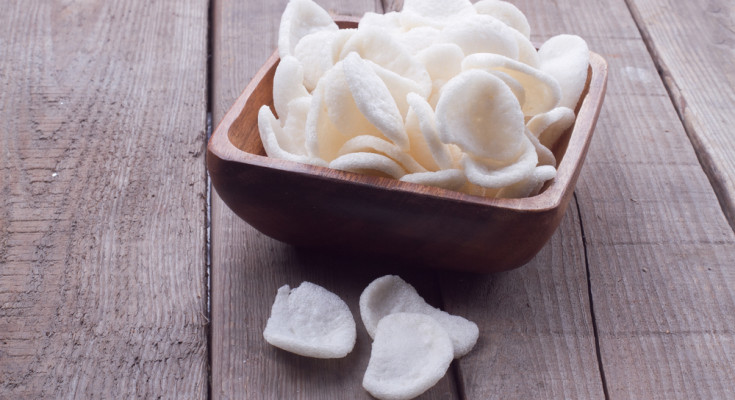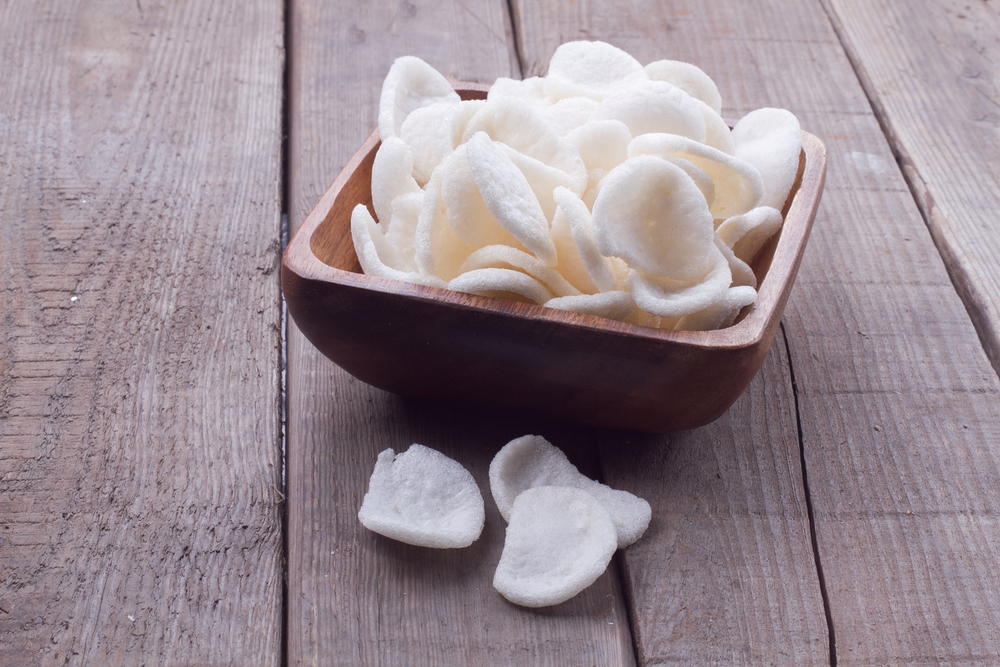By: Evi Mariani
|
In the annals of Indonesian cuisine, there is one food whose importance is often overlooked. This is the krupuk-a crispy wafer whose name is most likely derived from the sound it makes between one’s teeth. Krupuk are similar to Western crackers, the major difference being that they are not really a snack, but are typically consumed along with rice and side dishes.
Different brands of krupuk are available, most with simple brand names Many Indonesians lose their appetites if their meals don’t come with krupuk. Thus this food is quite easy to find. Just take a look around the small warung restaurants of Indonesia and you’ll see large tin boxes, often called blek, filled with krupuk and lined up in rows on the counters. These boxes are crafted of multi-colored tin with glass fronts that allow customers to peer at the contents. Different brands of krupuk are available, most with simple brand names like Sabar (patient), Subur (fertile), Makmur (prosperous), Sarirasa (flavor essence), Barokah (blessings), Idaman (craving) or Jujur (honest). White krupuk, pink krupuk, yellow krupuk Wafers Krupuk is in fact a generic name for wafers made from a variety of substances. There are shrimp krupuk, fish krupuk and vegetable krupuk, white krupuk, pink krupuk, yellow krupuk and brown krupuk. All these krupuk are made using similar techniques. Flour (wheat, tapioca or rice, depending on the type of krupuk) and water are blended with flavorings and cooked until the mixture becomes a dough. They are then shaped and dried until they turn into hard, plastic-like disks which, if stored properly, will keep for months. Before being served, the krupuk are dropped in hot oil where they expand, almost like magic, to several times their original size. Once cooked, a krupuk should be consummately crunchy. When bitten, it should make a distinctive kriuk sound. If it doesn’t crunch, it’s not a krupuk, or else it’s a soggy krupuk, which most Indonesians would agree is worse than no krupuk at all. Out of the vast variety of krupuk available, krupuk melarat or ‘suffering krupuk’ are the most popular, especially on the island of Java. These krupuk are quite inexpensive, selling for between 50 and 200 rupiah a piece, depending on their size. They are made of tapioca flour, the dough shaped into long strands and then wound, like the coils of a snake, into circles, ovals or triangles. They are served freshly fried and sold in colored tins. When they’re done right, the kriuk is perfect. Porridge There are many ways to enjoy krupuk, depending on the tastes and creativity of the consumer. The most popular way to eat them is along with a rice meal, nibbling on them in between bites. Some, however, like to eat krupuk with liquidy foods like soups or stews. The krupuk are dipped in the gravy until they lose their shape and become porridge-like. Still others treat krupuk like a snack, fishing one out of the can and enjoying it straight. No one seems to know why, but the weather also affects the consumption of krupuk. All the krupuk factories report that their sales are much higher during the rainy season. Is this because it’s pleasant to eat something crispy when everything else around is damp and chill? There’s no way to tell for sure except to try it yourself… Images from Shutterstock First published in Latitudes Magazine |












